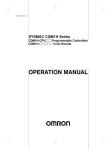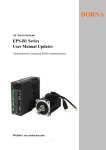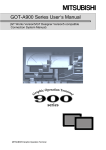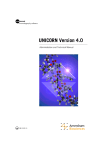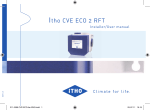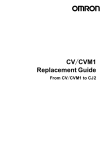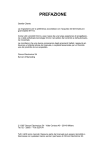Download Embedded Solution Strategies
Transcript
Embedded Solution Approaches Through Equipment Design Strategies Mark Stephens, PE Manager Industrial Studies Electric Power Research Institute 942 Corridor Park Blvd Knoxville, Tennessee 37932 Phone 865.218.8022 [email protected] Embedded Solution Strategies • Use “Selective Power Conditioners” on susceptible loads CVT DPI DySC Low Voltage CoilLock Ride Through Module • Embed the Solution through proper design, configuration and component selection strategies Vacuum Pumps • Utilize a Combination of both strategies © 2009 Electric Power Research Institute, Inc. All rights reserved. 2 DC Power Contactors Supplies Relays Method 1: Design with DC Power • One of the best methods of increasing the tolerance of control circuits is to use direct current (DC) instead of alternating current (AC) to power control circuits, controllers, input/output devices (I/O), and sensors. • DC power supplies have a “built-in” tolerance to voltage sags due to their ripple-correction capacitors, whereas control power transformers (CPTs) and AC components do not have inherent energy storage to help them ride through voltage sags • Many OEMs are moving in this direction to harden their equipment designs © 2009 Electric Power Research Institute, Inc. All rights reserved. 3 DC Powered Emergency Off Circuit Demonstration Time – PLC using DC Power Supply Rather Than CPT • How Much Better is the DC solution? – Depth of Sag – Duration of Sag • What other benefits does DC have? • What are some design considerations with DC? DC Powered PLC Circuit © 2009 Electric Power Research Institute, Inc. All rights reserved. 4 DC Powered PLC System in Weld Shop 100% Magnitude (Percentage of Pre-Sag Voltage) 90% 80% 70% 60% 50% 40% 30% 20% 10% 0% 0 5 10 15 20 25 30 35 Duration (cycles) Min Phase-to-Phase © 2009 Electric Power Research Institute, Inc. All rights reserved. 5 AB SLC-5/X PLC 40 For 480Vac 3-Phase Systems One Can Utilize a 3-Phase 480Vac Input DC Output P/S Power One Phoenix Contact © 2009 Electric Power Research Institute, Inc. All rights reserved. 6 Servo Drives Can Be Specified for DC Input Rather Than AC Input • Many items such as Servo Drives can be bought with AC input or DC input options Pacific Scientific PC3400 Series Digital Brushless Servo Drives • Specifying a DC input option and utilizing a robust DC power supply scheme can make servo controls robust to voltage sags • Removes Voltage Sag Issue from Servo Drive © 2009 Electric Power Research Institute, Inc. All rights reserved. 7 Summary of Robust Power Supply Strategies © 2009 Electric Power Research Institute, Inc. All rights reserved. 8 Summary of Robust Power Supply Strategies: Relative Power Supply Response at 100% Loading Ride-Through for Single-Phase Voltage Sags © 2009 Electric Power Research Institute, Inc. All rights reserved. 9 Method No. 2: Utilize Sag Tolerant Components • IF AC Relays and Contactors are used in the semiconductor tool design, then utilize compliant devices. • Consider response at both 50 and 60 Hz. • We have certified a many relays and contactors to SEMI F47. © 2009 Electric Power Research Institute, Inc. All rights reserved. 10 Example Robust Contactor Telemecanique LC1F150 Coil LX9FF220 Voltage Sag Ride Through Curve Voltage (% of Nominal) DUT 60HZ SEMI F47 DUT 50HZ 100% 80% 60% 40% 20% 0% 0 0.1 0.2 0.3 0.4 0.5 0.6 Duration (in seconds) © 2009 Electric Power Research Institute, Inc. All rights reserved. 11 0.7 0.8 0.9 1 Example Voltage Sag Response of Motor Controls Based on Robustness of Components © 2009 Electric Power Research Institute, Inc. All rights reserved. 12 Method 3: Apply Custom Programming Techniques – Delay Filters • Delay filters can be verify the presence of power and work as a “de-bounce” mechanism for when components drop out due to a voltage sag. The PLC motor-control circuit shown demonstrates how this method can be applied. • The program is designed to detect whether the auxiliary contact is open for more than 250 milliseconds. • If the contact is open for more than that preset time, then the “Timer On Delay Coil” in Rung 2 will be set and unlatch the previous rung to remove voltage from the motor starter. © 2009 Electric Power Research Institute, Inc. All rights reserved. 13 Method 3: Apply Custom Programming Techniques – Delay Filters © 2009 Electric Power Research Institute, Inc. All rights reserved. 14 Method 3: Apply Custom Programming Techniques –State Machine Programming • State Machine Programming is based on the idea that manufacturing processes are comprised of a number of steps with the goal of producing and moving a product. • Therefore, machine-state programming keeps track of every sequential process state and associated variables by writing variables to non-volatile memory in the event power is lost. • When power returns, the processing step number and variables can be recalled so that the machine can continue from where it stopped. © 2009 Electric Power Research Institute, Inc. All rights reserved. 15 Method 3: Apply Custom Programming Techniques – Programming Using Phase/Voltage Sensing Relay • A phase monitor or voltage sensing relay, used in conjunction with programming, can also protect against the effects of voltage says. • The relay contacts can be used to run a check on the system, retrieve past information stored in memory, or hold control parameters constant until the event is over. © 2009 Electric Power Research Institute, Inc. All rights reserved. Potential Sensing Devices For Voltage Sags (Left to Right) Phase Monitoring Relay PQ Relay “Original” PQ Relay (AC Ice Cube) 16 Method 4 – Examine Configuration Settings • A low-cost or perhaps no-cost method of increasing the tolerance of AC and DC motor drives to voltage sags is through software configuration settings. • This method applies to all types of drives, including, but not limited to, AC pulse-width modulation (PWM), directcurrent, AC-pulse, stepper, and servo drives. © 2009 Electric Power Research Institute, Inc. All rights reserved. 17 Method 4 – Examine Configuration Settings Functional Description: Automatic Reset and Automatic Restart • In most cases, drive manufacturers give users access to basic microprocessor program parameters so that the drive can be configured to work in the user’s particular application. • A drive’s programming parameters associated with reducing the effect of voltage sags are seldom describes in one section of the user manual. © 2009 Electric Power Research Institute, Inc. All rights reserved. 18 Method 4 – Examine Configuration Settings Functional Description: Motor Load Control Motor-load control uses the motor’s inertia or controlled acceleration/deceleration to ride-through voltage sags. © 2009 Electric Power Research Institute, Inc. All rights reserved. 19 Method 4 – Examine Configuration Settings Functional Description: Phase Loss and DC Link Undervoltage Detecting a loss of phase enables a drive to delay a fault condition and ride through the loss of phase. The DC link undervoltage trip point can be adjusted to enable a drive to ride through sags. © 2009 Electric Power Research Institute, Inc. All rights reserved. 20 Method 4 – Examine Configuration Settings Functional Description: Limits Rate of acceleration, rate of deceleration, current limit, and torque limit are parameters that affect the way a drive attempts to recover after a voltage sag. © 2009 Electric Power Research Institute, Inc. All rights reserved. 21 Example Settings Rockwell Power Flex 70 & 700 • Conducted SEMI F47 compliance Testing on Power Flex 70 and 700 Series drives in EPRI Lab. • Drives have built in parameters that can be used to improve voltage sag performance. • Drives loaded to 100% © 2009 Electric Power Research Institute, Inc. All rights reserved. 22 PowerFlex 70 and 700 Ride-Through Parameters • Two distinct modes of operation, ASD, to help with “Ride-Through” ¾ “Inertia ride-through” or “Decel” mode ASD attempts to maintain the DC bus voltage at certain level by regenerating power from load More output speed droop relative to “Continue Mode” For a given sag duration, DC bus voltage will not droop as much as “Continue” mode ¾ “Continue Mode” For a given sag duration, larger DC bus voltage droop than “Decel” mode Less output speed droop relative to “Decel” mode Drive is allowed to run at set-speed and load Depending on duration of sag and the level of bus voltage droop • May result “undervoltage” fault Increased output current to maintain load • ASD may trip on “Overload” © 2009 Electric Power Research Institute, Inc. All rights reserved. 23 Typical Drive Test Setup Dynamometer Control System Test Setup for Larger Drives (20 to 150HP) Voltage Sag Generator Nicolet Data Recorder Drive Under Test Dynamic Dyno AC Motor Motor Load Drive Under Test Test Setup for Smaller Drives Eddy Current Brake Motor Load (2 to 15 HP) Nicolet Data Recorder Voltage Sag Generator © 2009 Electric Power Research Institute, Inc. All rights reserved. 24 PowerFlex® 70 Drive Parameters Important for Power Quality Robustness Parameter Setup Par No. 169 174 184 185 © 2009 Electric Power Research Institute, Inc. All rights reserved. Name and Description Setting [Flying Start En] Enables/Disables the function which reconnects to a spinning motor at actual RPM when a start command is issued. [Auto Rstrt Tries] Sets the maximum number of times the drive attempts to reset a fault and restart. Default: 0 “Disabled” [Power Loss Mode] Sets the reaction to a loss of input power. Power loss is recognized when: • DC Bus Voltage is <= 73% of [DC Bus Memory] and [Power Loss Mode] is set to “Coast” • DC Bus Voltage is <= 82% of [DC Bus Memory] and [Power Loss Mode] is set to “Decel” [Power Loss Time] Sets the time that the drive will remain in power loss mode before a fault is issued. 25 Related Par. 170 Options: 0 “Disabled” 1 “Enabled” Default: 0 175 Options: Min/Max: 0/9 Units: 1 Default: 0 “Coast” 013 185 Options: 0 “Coast” 1 “Decel” 2 “Continue” Default: 0.5 Sec Options: Min/Max: 0.0/60.0 Sec Units: 0.1 SEMI F47 Setup Considerations If drive experiences an overcurrent or undervoltage fault during a voltage sag event, then this parameter can allow it to catch the spinning motor if Parameter 174 [Auto Rstrt Tries] is set to any value except default. Must have this parameter set to something other than default in order to reset an overcurrent fault or undervoltage fault and allow the drive to catch the spinning motor. Set to a value of “2” for continuous speed operation. The drive will work to maintain speed by drawing more current during the voltage sag. 184 Default Setting should be sufficient for SEMI F47 duration voltage sags. Test Result – Default Configuration: P184=0 No Yes SEMI F47 Test - Adjustable Speed Drive Data Sheet RA_ASD_1 20AD8P0A3AYYNDNN Power Flex 70, 5HP 480Vac 1730 60 7/19/2005 Dennis Turner FLA=6.5 © 2009 Electric Power Research Institute, Inc. All rights reserved. Yes Yes No No 1704 1692 736 647 26 Min. Speed % of Nom. Yes Yes Yes Yes 98% 98% 43% 37% Speed Remain above 95% 98% 97% 30% 31% Automatic Restart 1696 1684 525 530 Min. Speed (rpm) 80% 70% 50% 50% Speed Remain above 95% 60.0 30.0 12.0 3.0 Without Line Reactor Automatic Restart SEMI F47 Standard Test Points 1 0.5 0.2 0.05 Min. Speed (rpm) Cycles 60Hz With Line Reactor Sec. Duration Notes: FW 2.009 Power Flex 70 Control Board Default Configuration Parameter 184 Decel Set to "0" Min. Speed % of Nom. Test Designator: Model: Specs: Nom. Voltage: Nom. Speed (rpm): Freq.(Hz) Date: Tester: Yes Yes Yes Yes Yes Yes No No Test Result – Default Configuration: P184=1 “Decel” Mode No Yes SEMI F47 Test - Adjustable Speed Drive Data Sheet RA_ASD_1 20AD8P0A3AYYNDNN Power Flex 70, 5HP 480Vac 1730 60 7/19/2005 Dennis Turner FLA=6.5 © 2009 Electric Power Research Institute, Inc. All rights reserved. Yes No No No 1708 1232 1290 1618 27 99% 71% 75% 94% Speed Remain above 95% Yes Yes Yes Yes Automatic Restart 98% 77% 78% 94% Min. Speed (rpm) 1699 1328 1349 1622 Speed Remain above 95% 80% 70% 50% 50% Automatic Restart SEMI F47 Standard Test Points 60.0 30.0 12.0 3.0 Min. Speed (rpm) Cycles 60Hz 1 0.5 0.2 0.05 Min. Speed % of Nom. Without Line Reactor With Line Reactor Sec. Duration Notes: FW 2.009 Power Flex 70 Control Board Default Configuration Parameter 184 Decel Set to "1" Min. Speed % of Nom. Test Designator: Model: Specs: Nom. Voltage: Nom. Speed (rpm): Freq.(Hz) Date: Tester: Yes Yes Yes Yes Yes No No No Example Response • Example Worst Case Speed Deviation: 12 Cycles, 50% Vab without Line Reactor • Set for P184= “DECEL” mode © 2009 Electric Power Research Institute, Inc. All rights reserved. 28 Test Result – Default Configuration: P184=2 “Continue” Mode No Yes SEMI F47 Test - Adjustable Speed Drive Data Sheet RA_ASD_2 20BD011A0AYNANCO Power Flex 700, 5HP 480Vac 1730 60 7/19/2005 Dennis Turner © 2009 Electric Power Research Institute, Inc. All rights reserved. Yes Yes No Yes 1703 1694 1662 1677 29 Min. Speed % of Nom. Yes Yes Yes Yes 98% 98% 96% 97% Speed Remain above 95% 98% 97% 94% 96% Automatic Restart 1694 1681 1627 1655 Min. Speed (rpm) 80% 70% 50% 50% Speed Remain above 95% 60.0 30.0 12.0 3.0 Without Line Reactor Automatic Restart SEMI F47 Standard Test Points 1 0.5 0.2 0.05 Min. Speed (rpm) Cycles 60Hz With Line Reactor Sec. Duration Notes: FW 4.002, Vector Control Power Flex 70 Control Board Default Configuration Parameter 184 Set to "2" Cont Min. Speed % of Nom. Test Designator: Model: Specs: Nom. Voltage: Nom. Speed (rpm): Freq.(Hz) Date: Tester: Yes Yes Yes Yes Yes Yes Yes Yes Example Response • Example Worst Case Speed Deviation: 12 Cycles, 50% Vab without Line Reactor • Set for P184= “Continue” mode © 2009 Electric Power Research Institute, Inc. All rights reserved. 30 Schneider-Toshiba Altivar 61 & 71 Drives • This newer drive series was recently tested as a part of the EPRI PQ Star SEMI F47 compliance program. • Drives were found to pass the standard. • Certification Relates to multiple drive models manufactured from same control platform – STI Altivar 61 and 71 – ELIN >pDRIVE< – MX ECO and MX PRO Altivar 61 and 71 Series Drives © 2009 Electric Power Research Institute, Inc. All rights reserved. 31 Schneider-Toshiba Altivar 61 & 71 Drives • The drives were able to pass the SEMI F47 testing requirements when configured properly. • Prameters such as "Input Phase Loss", "Catch on the Fly", and Undervoltage Timeout (UV Timeout) had to be set. • The dynamic torque profile was test to follow the "High Torque A" and the default slip compensation was set to 100%. © 2009 Electric Power Research Institute, Inc. All rights reserved. 32 Parameter Setting Input Phase Loss Ignore Catch on Fly Yes UV Timeout 3 sec UV Prevention DC maintain Slip Compensation 100% (default) Dynamic Torque High Torque A Example System with Drives • 750VA 480/120 CPT • DC Powered PLC • AC and DC I/O • Drives have line reactors • Drives Have Restart on Power Loss Parameters – MUST CONSIDER SAFETY ISSUES WITH AUTO RESTART • Could be robust to 50% of nominal sag without conditioning • Solution – Option 1: • 750VA MiniDySC on 120Vac controls $1320 • www.sagshappen.com – Option 2: • 1kVA 480 3-phase, 120 Vac output Power Ride RTD • $1,180 © 2009 Electric Power Research Institute, Inc. All rights reserved. 33 Method 5 – Select Appropriate Trip Curves for Circuit Breakers • Some equipment, especially equipment with AC-to-DC converters, may respond to a voltage sag by drawing inrush current when the voltage supply returns to normal. • During a voltage sag, the AC-to-DC converter capacitors discharge. At the end of the sag, the sudden presence of a full voltage causes the discharged capacitors to rapidly recharge. • The magnitude of this inrush of current depends on the depth and duration of the voltage sag. The resulting current transient may be large enough to trip circuit breakers that have a quick response time. • Process machines with any type of AC-to-DC converter—such as DC power supplies, AC or DC variable-speed drives, and servo drives—can not only cause such transients but may also be susceptible to breaker trips caused by the transients. © 2009 Electric Power Research Institute, Inc. All rights reserved. 34 Method 5 – Select Appropriate Trip Curves for Circuit Breakers This voltage sag to 40% of nominal voltage caused the capacitors in a variable-frequency drive to discharge. When the input voltage returned to normal after six cycles, the capacitors suddenly charged, causing an inrush current transient that peaked at 360% of the normal operating current. © 2009 Electric Power Research Institute, Inc. All rights reserved. 35 Method 5 – Select Appropriate Trip Curves for Circuit Breakers – Case Study • Power Supply design was modified to lower the DC bus undervoltage trip point of the unit after failing initial SEMI F47 testing. • SEMI F47 Tests were again conducted after the modifications. • Circuit Breaker was found to then trip, leading to noncompliance of the unit as a whole. • The Unit was fitted with a new circuit breaker of the same amperage value, without an instantaneous trip. • Unit then passed SEMI F47 tests. © 2009 Electric Power Research Institute, Inc. All rights reserved. 36 Method 5 – Select Appropriate Trip Curves for Circuit Breakers – Case Study © 2009 Electric Power Research Institute, Inc. All rights reserved. 37 Other Considerations • Make sure the device rated voltage matches the nominal voltage. Mismatches can lead to higher voltage sag sensitivities (for example 208Vac fed to 230Vac rated component). • Consider Subsystem performance. Vendor subsystems must be robust for the entire system to be robust. Otherwise, power conditioning may be required for the subsystem. • Consolidate Control Power Sources. This will make the implementation of any required power conditioner scheme much simpler and cost effective. • Use a targeted voltage conditioning approach as the last resort. Apply Batteryless power conditioner devices where possible (next session) © 2009 Electric Power Research Institute, Inc. All rights reserved. 38 Case Study Magnet Wire Plant Resolves PQ Issues Introduction • A magnet wire plant experienced voltage-sag-related process upsets on several of its wire manufacturing lines. • The plant load was approximately 5 MVA and was fed from three 2MVA transformers. • In addition to the wire lines, other important process sections of the plant include a rod mill and enamel, lubricant, and mechanical-room systems. • In order to decrease the susceptibility of the plant to power quality (PQ) disturbances, the local utility supplying the magnet wire plant requested that EPRI provide a detailed PQ audit. • The PQ audit revealed that several controls were susceptible to power quality disturbances. © 2009 Electric Power Research Institute, Inc. All rights reserved. 40 Background (1) • The need to provide reliable power with a steady voltage and frequency has been recognized since the inception of the electric utility industry. • Voltage sags are the most important power quality variation affecting equipment because statistically they are the most frequent. – This was determined in the EPRI Distribution Power Quality (DPQ) study. – Lightning strikes, animals, fires, equipment failure, auto and construction accidents, and wind are some of the causes for power system faults. © 2009 Electric Power Research Institute, Inc. All rights reserved. 41 Background (2) • Voltage sags, a decrease in RMS voltage at the power frequency for durations of 0.5 cycles to 1 minute, and interruptions are caused by faults (short circuits) on the power system. • The location of the fault and the power system configuration determine the severity of voltage sags, while the power system protection scheme usually determines the duration. • Below is a voltage sag characterized by a duration of four cycles and a depth of 50%. © 2009 Electric Power Research Institute, Inc. All rights reserved. 42 Background (3) • In the United States, a typical voltage sag is: – 6–10 cycles (100–167 milliseconds) in duration – Greater than 60% to 70% of nominal voltage in magnitude – Typically single-phase and appears in either one or two phases inside the plant. • A momentary interruption occurs when the supply voltage decreases to less than 10% of nominal for a period of time not to exceed 1 minute. – These Interruptions are measured by duration since the voltage magnitude is always less than 10% of nominal. – Typical duration for interruptions is 30–120 cycles (0.5–2.0 seconds) and depends on recloser fault clearing time. Actual Interruption Waveform and RMS Plot Typical Interruption Event Waveform © 2009 Electric Power Research Institute, Inc. All rights reserved. 43 Background (3) • The magnet wire plant is supplied by a local substation that is fed from a tapped 115-kV transmission line jointly owned by two other utilities. • The “scatter plot” below shows the voltage sags experienced by the plant from April 2000 to October 2001. – It is a composite of single-phase data from the 115-kV line and the plant’s incoming transformer voltage. – The PQ data was recorded by two digital fault recorders (A and B). • Analysis of the data reveals that the magnet wire plant had reported upsets for voltage sags ranging from 3 cycles, 78% of nominal voltage to 18 cycles, 89% of nominal. Actual Interruption Waveform and RMS Plot © 2009 Electric Power Research Institute, Inc. All rights reserved. 44 Plant Power Quality Assessment (1) • The magnet wire plant utilizes programmable logic controllers (PLC) and AC drive technology as the backbone of the control systems. • Typically, the characteristics of a robust PLC-based control system are: • DC-powered PLC power supply • DC-powered input/output (I/O) and control power • Robust AC drives • A scoring system was used to evaluate the susceptibility of various manufacturing lines in the plant to power quality disturbances. Summary of Power Quality Attributes for PLCs and AC Drives © 2009 Electric Power Research Institute, Inc. All rights reserved. 45 Plant Power Quality Assessment (2) • Based on this summary table, it is apparent that the magnet wire plant uses a large number of drives. • The PQ audit revealed that several PLCs and I/Os are AC powered, making them susceptible to voltage sag events. PLC Cabinet Powered by AC with a Mixture of AC and DC I/O DC-Powered PLC and I/O with Four Motor Drives © 2009 Electric Power Research Institute, Inc. All rights reserved. 46 Plant Power Quality Assessment (3) • The weighted calculations for each process area’s PQ performance is scored based on the system discussed earlier. • Scores of zero or less are susceptible to voltage sags and all others have some degree of robustness Weighted Score Assessment of Various Manufacturing Lines in Magnet Wire Plant © 2009 Electric Power Research Institute, Inc. All rights reserved. 47 Recommendations for Hardening Magnet Wire Plant to Power Quality Disturbances • • • A detailed assessment and inspection of various electrical controls in the magnet wire plant revealed that several manufacturing lines were susceptible to power quality disturbances. The audit recommended all possible options with particular emphasis on low-cost modifications by changing AC drive firmware and adding small power conditioners to control circuits in the plant. Power quality solutions can range from thousands of dollars to millions of dollars. Effect of Equipment Sensitivity Information on Cost of PQ Solution © 2009 Electric Power Research Institute, Inc. All rights reserved. 48 Recommendations for Hardening Magnet Wire Plant – Distributed Power Conditioning • A number of controls in the magnet wire plant are fed from AC power. – One recommendation is to provide small “batteryless” power conditioners for equipment supplied by AC control transformers. – The power conditioners can be installed on the secondary side of the control power transformers. Example Batteryless Power Conditioners © 2009 Electric Power Research Institute, Inc. All rights reserved. 49 Recommendations for Hardening Magnet Wire Plant – Firmware Upgrade • The magnet wire plant uses several AC drives of a single make. • AC drives are susceptible to voltage sags in which the DC bus level drops to 81% of nominal or less. – Test results at EPRI in the past indicate lowering the DC bus trip level will greatly increase the ridethrough. • Each drive must be retrofitted with a new language module firmware revision to allow a lower DC bus voltage trip setting to 50%. • This is a typical low-cost solution as firmware upgrades are relatively inexpensive. © 2009 Electric Power Research Institute, Inc. All rights reserved. 50 Cost-Benefit Analysis of Recommended Power Quality Improvement Solutions • • Below is a summary of the recommendations and estimated typical costs based on the first two recommendations in the previous slides (distributed power conditioning and firmware upgrades). For the purposes of cost calculation for the third recommendation (using a centralized power conditioning system), a mid-range price of $300 per kVA will be used. – The centralized method equates to roughly $600,000 per 2-MVA transformer or $1.8 million for 3 transformers. Cost for Distributed Power Conditioning and Firmware Update Recommendations © 2009 Electric Power Research Institute, Inc. All rights reserved. 51 Test Validation of Recommendations (1) • PQ testing was performed on one selected line to evaluate the actual line susceptibility as well as to validate the low-cost recommendation of upgrading firmware and setting drive bus trip level to 50%. – Line testing was conducted to prove firmware upgrades improved the ride-through performance. • The testing strategy was to characterize the AC drives with the firmware upgrade installed and then test again without the existing firmware revision. • The voltage sag generator was placed in series with the 480-Vac source and the take-up control. © 2009 Electric Power Research Institute, Inc. All rights reserved. EPRI Voltage Sag Generator Electrical Hook-Up 52 Test Validation of Recommendations (2) • The oven was tested at various voltage levels and durations to characterize the ability of the equipment to ride through voltage sags. • Below lists the test points agreed upon by the team and all voltage sags were performed phase to phase. Horizontal Line Take-Up Drive Cabinet Voltage Sag Test Points © 2009 Electric Power Research Institute, Inc. All rights reserved. 53 Test Validation of Recommendations (3) • During the sag testing of the horizontal line with the firmware upgrades, it was discovered that a two-phase sag of any duration to 60 cycles with a magnitude down to 35% nominal would not trip AC drives off-line. – Testing below 35% of nominal was discontinued as the inrush current was in excess of 90 amps and might destroy the rectifiers in the drive. • Similarly, the test was repeated on a line with no firmware updates installed. – The unprotected drive yielded its first trip at 12 cycles, 70% nominal by shutting down the drive, thus breaking the magnet wire. • Repeated testing revealed that the unprotected AC drives tripped more often. © 2009 Electric Power Research Institute, Inc. All rights reserved. 54 Test Validation of Recommendation (4) • Based on the testing, sag ride-through curves were compiled. • These curves show that a simple update to the drive firmware and resetting of the DC bus trip levels to 50% will significantly harden the line’s susceptibility to voltage sags. © 2009 Electric Power Research Institute, Inc. All rights reserved. 55 Industrial Case Study: Monitor Manufacturer The “Engineering” of Embedded Solution • Initial dialogue established between plant personnel and utility PQ group. • Remote gathering of information, plant/equipment one-line diagrams, process upset logs, PQ monitoring data. • One week investigation at the plant – Get buy-in from the process managers – Understand the process – Talk with the process floor people – Evaluate sensitivity – Investigate hidden weak links – Evaluate solution options – Cost benefit analysis – Recommendation to process managers © 2009 Electric Power Research Institute, Inc. All rights reserved. 57 Production Lines • Line A manufactures 19" CRTs for monitors with provisions for 21" • Line B manufactures flat panel 19” CRTs for monitors with provisions for 17”. • Pegasus Line manufactures 17” CRTs for PC monitors. • 32” line manufactures TV CRTs . • 27” Line manufactures TV CRTs • 20” Line manufactures TV CRTs. © 2009 Electric Power Research Institute, Inc. All rights reserved. 58 Financial Impact of Three Events Date Impact # of Units Rejected (A) Downtime in Minutes # of Units missed due to downtime (based on 28 second Mercury Index time) (B) Total # of Units missed (A) + (B) Total Cost (based on $180 per unit) 11/19/98 Power fluctuation caused CS light houses to trip 30 20 43 73 $13,140 11/23/98 Power Glitch AG, SCR, PII, Lost all screening 73 48 103 176 $31,680 01/26/99 Power glitch in screening process 44 10 22 66 $11,880 147 78 168 315 $56,700 Total © 2009 Electric Power Research Institute, Inc. All rights reserved. 59 Voltage Sag Characteristics Inside the Plant Cumulative Histogram for 208V 1994 1995 1996 1997 1998 1999 50 43 45 Number of Events 40 35 29 110 Total Events 30 25 20 15 11 10 1 10 20 1 1 1 65 1 1 60 2 5 5 5 8 4 2 RMS Voltage Magnitude (in % of Nominal) © 2009 Electric Power Research Institute, Inc. All rights reserved. 60 100 95 90 85 80 75 70 55 50 45 40 35 30 25 15 0 Type of Events Momentary 3-Phase 2-Phase 1-Phase Number of Events 20 15 15 12 11 10 10 9 9 8 8 6 5 4 3 3 3 3 2 2 1 1 0 0 0 1994 1995 0 1996 1997 Year © 2009 Electric Power Research Institute, Inc. All rights reserved. 0 61 1998 0 1999 0 Block 10 PS 1 5 CS 2 Turntables CS 1 & CS 2 - Carbon Striping PS 1 - Green PS 2 - Blue PS 3 - Red PS 4 - Filmer END Screening Process LH LH LH LH B lo ck 6 LH PS 2 B lo ck 7 lo B LH PS 3 Lighthouses CS 1 Virgin Panel Wash (Block 3) Block 3 Conveyors from AG START Screening Process Flow Diagram © 2009 Electric Power Research Institute, Inc. All rights reserved. Block 4 PS 4 Aluminizer Carts ck 8 ck lo B LH B lo ck 9 Critical Process: Screening 62 Sensitive Equipment © 2009 Electric Power Research Institute, Inc. All rights reserved. 63 How Sensitive? (Higher Bar Means More Sensitive) 90% 4 % of Nominal Voltage 80% 7 5 70% 8 60% 50% 10 2 40% 9 6 30% 3 20% 10% 1 © 2009 Electric Power Research Institute, Inc. All rights reserved. 64 AC Contactor Servo Drive PLC @120 & 208V PLC @ 120V PLC @ 208V PLC @ 120V PLC @ 208V 24V DC PS 24V DC PS 24V DC PS 0% Embedded Solution Change PLC Input from AC to DC input. Use a 3-Phase AC input to 24VDC output Power supply. If PLC AC power supply is integrated to the Module use a small power conditioning (e.g., Dip Proofing Inverter or CVT). © 2009 Electric Power Research Institute, Inc. All rights reserved. 65 AC Versus DC Input for PLCs © 2009 Electric Power Research Institute, Inc. All rights reserved. 66 How Effective is a 3-Phase AC Input to 24V DC output Phoenix Contact PS PLC Power Supply unit 24V DC Source Loading on 24V DC Source Voltage Sensitivity Threshold (in %) for 30 Cycle RideThrough Three Phase Sags Two-Phase Sags Single-Phase Sag CV500-PS211 Phoenix Contact 20%1 0% 0% 0% CV500-PS211 Phoenix Contact 35% 45% 0% 0% CV500-PS211 Phoenix Contact 60% 50% 0% 0% 3-Phase Sag Tester 208V 3-Phase Utility Source © 2009 Electric Power Research Institute, Inc. All rights reserved. Phoenix Contact 24V DC Power Supply PLC PLC Power CPU Supply PS211 67 Wire Spool (Additional Load) I/O Racks How Effective is this Solution? Impact of Decreasing Voltage Sag Sensitivty of PLC With No Improvement Redcuing Sensitivity of PLC to 50% of Nominal 20 18 18 Number of Process Upsets 16 15 14 12 12 10 8 6 6 6 4 3 2 1 1 1 0 0 1994 © 2009 Electric Power Research Institute, Inc. All rights reserved. 1995 1996 1997 68 1998 PLC Types Targeted Recommendation Based on PLC Type CQM1 (Small Range) C200Hα (Mid Range) CV Series: 500, 1000, 2000, M1 (Large Range) Existing 100240V AC PLC, I/O Rack Power Supply • CQM1 PA203 • CQM1 PA206 Replacement 24V DC Power Supply Not required; Existing power supply can withstand sags down to 30% of nominal voltage • PA204 CV500PS221 • CV500PS211 CVM1PA208 • 3G2A5PS212-E • PS223 • PS22E • • • C200H, C200HS, C1000H (older model PLCs) © 2009 Electric Power Research Institute, Inc. All rights reserved. 69 3G2A5PS22-E Power Supply Integral to CPU Unit Not available for PLCs with integral power supply; Requires 500VA DPI unit for PLC and I/O Rack power supply Lessons Learned • In designing new process lines use DC input controllers wherever possible. • Use a robust DC source for all your DC inputs (such as, 3Phase AC to 24V DC power supply) • Know the sag immunity of your DC power supplies in your plant. • See PEAC PQ Brief No. 49: Ride-Through Characteristics of PLC AC and DC Power Supplies © 2009 Electric Power Research Institute, Inc. All rights reserved. 70









































































